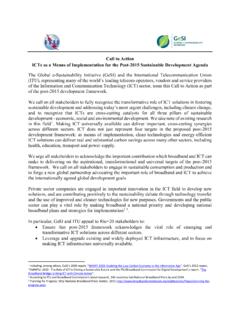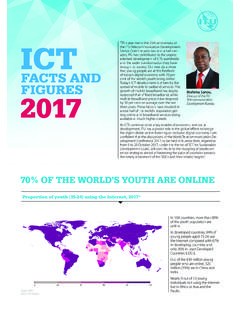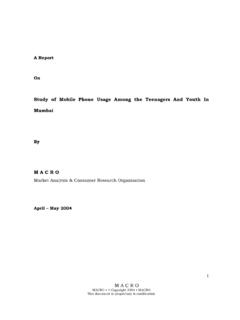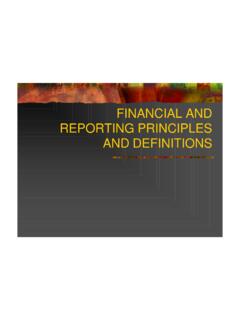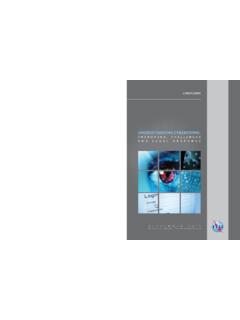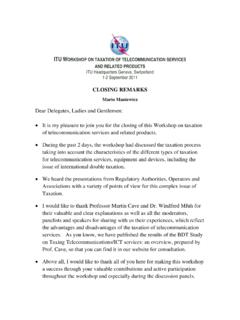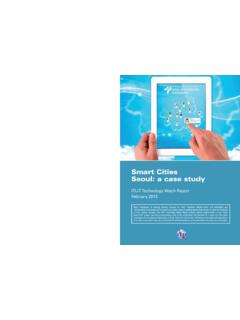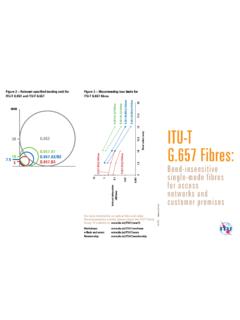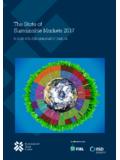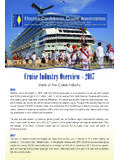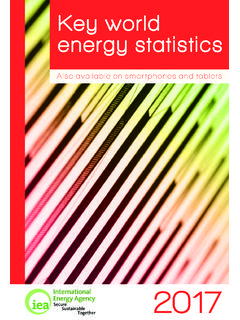Transcription of 3 - TT
1 Printed in SwitzerlandGeneva, 2017 International Telecommunication UnionPlace des NationsCH-1211 Geneva 20 SwitzerlandMeasuring the Information Society Report 2017 - Volume 1 Measuring the Information Society Report 2017 Volume 19 7 8 9 2 6 1 2 4 5 2 1 44 1 3 5 1 Measuring the Information Society ReportVolume 12017 2017 ITU International Telecommunication Union Place des Nations CH-1211 Geneva SwitzerlandOriginal language of publication: EnglishAll rights reserved. No part of this publication may be reproduced, stored in a retrieval system, or transmitted in any form or by any means, electronic, mechanical, photocopying, recording, or otherwise, without the prior permission of the International Telecommunication :978-92-61-24511-5 (Paper version) 978-92-61-24521-4 (Electronic version) 978-92-61-24531-3 (EPUB version) 978-92-61-24541-2 (Mobi version)iiMeasuring the Information Society Report 2017 - Volume 1iiiIt is my pleasure to present to you the latest edition of the Measuring the Information Society Report.
2 This annual report presents a global and regional overview of the latest developments regarding information and communication technologies (ICTs), based on internationally comparable data and agreed methodologies. It aims to provide ITU Member States with an objective assessment of countries ICT performance by highlighting areas of success stories and areas that need further improvement. The release of this report comes after the successful conclusion of the World Telecommunication development Conference (WTDC), held in Buenos Aires, Argentina, where we adopted a Strategic Plan and Action Plan that will provide future direction and guidance to the ITU Telecommunication development Sector (ITU-D), including its work on statistics . Based on ITU data collections, the report gives an overview of the long-term telecommunication/ICT trends. Analysis shows an overall upward trend in the availability of communication services, driven by rapid growth in broadband, with a growing predominance of mobile over fixed services.
3 Globally, the number of mobile-cellar subscriptions grew from 2005 to 2017 from per 100 inhabitants to an estimated In the least developed countries (LDCs), the growth has been more impressive, increasing from in 2005 to an estimated in trends are brought further into evidence by the ICT development Index (IDI). The IDI is a powerful tool for monitoring progress towards a global information society and is a core feature of this report. The latest IDI ranks the performance of 176 economies with regard to ICT infrastructure, use and skills, allowing for comparisons to be made between countries and over time. The most important aspect of the IDI is that countries should track their own year on year progress and make policy adjustments to grow their countries telecommunication/ICT year s Index shows that there has been continued improvement in IDI performance by the great majority of countries.
4 The average value for all economies in the Index rose by points between IDI 2016 and IDI 2017 , reaching points, the first time that it has exceeded the halfway point along its scale. Improvements have been most significant among countries in the middle of the IDI rankings, many of which are middle-income developing countries, testifying to the fact that these countries are catching up with the top performers when it comes to ICT development . But LDCs as well improved their average IDI value, by points during the year, close to the overall average growth recorded. Mobile broadband is the driving force behind this trend, bringing online previously unconnected individuals and catering for the ubiquitous data needs of the ICT ecosystem. Worldwide, active mobile-broadband subscriptions increased from per 100 inhabitants to in only 7 years. Here as well, growth in LDCs was even stronger, from in 2010 to in 2017 , offering hope that they are on a path to catch up with the rest of the developments in ICT markets have led to the adoption of proposals for change in the composition of the Index.
5 A revised set of indicators will be introduced from IDI 2018 which should add further insights into the performance of individual countries and the relative performance of countries at different development the Information Society Report 2017 - Volume 1 ForewordivMeasuring the Information Society Report 2017 - Volume 1 Over and above reporting on the overall telecommunication/ICT progress achieved, the IDI also shows that the digital divide between more and less connected countries remains a challenge which needs to be addressed if inclusive information societies are to contribute to the achievement of the Sustainable development Goals (SDGs). Digital divides are also evident within countries, for example between urban and rural areas and between age groups. In many countries, urban residents and young people are more likely to be online than rural dwellers and the elderly.
6 Women are less likely than men to make use of the Internet in most countries, but are more under-represented online in developing countries, particularly in LDCs, than in developed year s report also features a chapter presenting IDI findings at regional level and compares different regions. Given that there is a strong correlation between economic development and IDI performance, there are considerable differences between geographic regions in the levels of ICT development reflected by the IDI, and significant variation in the experiences of individual countries within each region. Drawing conclusions from the report, it is clear that the area of ICTs is very dynamic and that another digital revolution is approaching - one which will transform business, government and society. Four key developments are at the heart of this revolution: the Internet of Things (IoT), cloud computing, big data analytics, and artificial intelligence (AI).
7 These are described in greater detail in the last chapter of the report. All these trends are interrelated. Fully harnessing the economic and social benefits of these developments requires efficient and affordable physical infrastructures and services, more advanced user skills, and internationally comparable benchmarks and indicators supported by enabling public policies. Promising ICT applications in areas such as manufacturing, precision agriculture, government, education, health care, smart cities, and smart transportation, will contribute to accelerating the attainment of the SDGs. Reliable and meaningful measures of the deployment and use of advanced ICTs are critical. This topic will undoubtedly be dealt with further in future editions of the Measuring the Information Society Report. For the first time, this year s report features country profiles highlighting the ICT market structure and the latest developments in 192 economies worldwide.
8 Each profile includes an overview of the policy and regulatory initiatives undertaken, as well as the current status of network roll-out and service uptake. These profiles are presented in Volume 2 of the Measuring Information Society Report. The profiles seek to highlight the achievements by each country and I am confident that these profiles will also help in identifying good practices as well as future challenges specific to each is my hope that this report will not only be of value to actors within the ITU membership (policy-makers, regulators, the ICT industry, academia) but to others also working towards the building of an inclusive global information Sanou Director Telecommunication development Bureau (BDT) International Telecommunication UnionvThe 2017 edition of the Measuring the Information Society Report was prepared by the ICT Data and statistics Division within the Telecommunication development Bureau of ITU.
9 The work was carried out under the overall direction of Cosmas Zavazava, Chief, Projects and Knowledge Management Department, Telecommunication development Bureau. The team included Rati Skhirtladze, Fredrik Eriksson, Esperanza Magpantay, Lourdes Montenegro, Daniela Pokorna, Martin Schaaper and Ivan Vallejo. David Souter, consultant to ITU, provided substantive contributions to Chapters 1, 2 and 3. Johannes Bauer, consultant to ITU, provided substantive input to Chapter 4. The report includes data from Eurostat, the UNESCO Institute for statistics , the United Nations development Programme and the United Nations Population Division, which are duly also appreciates the cooperation of countries that have provided data included in this report was edited by Mark Woodall, from ITU, and Michael Gibson, consultant to ITU, with the assistance of the English Language Section. The desktop publishing was carried out by the ITU Publication Production Service, led by Simon De Nicola, and the cover was designed by Jes s Vicente.
10 Administrative support was provided by Mihaela the Information Society Report 2017 - Volume 1 AcknowledgementsForeword ..iiiAcknowledgements ..vTable of contents ..viiChapter 1. The current state of ICTs ..1 Key findings .. Introduction .. Basic communication networks .. Trends in broadband access .. Internet access and use .. Digital divides within society .. Summary and conclusion ..21 Chapter 2. The ICT development Index global analysis ..23 Key findings .. Introduction .. The ICT development Index .. Global IDI analysis .. The IDI and the digital divide .. Summary and conclusion ..56 Chapter 3. The ICT development Index regional and country analysis ..61 Key findings .. Introduction .. Regional IDI analysis .. Summary and conclusion ..90 Chapter 4. Emerging ICT findings .. Introduction .. Description of key trends.
